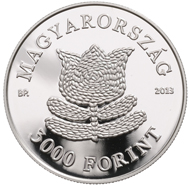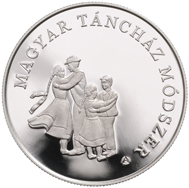March 7, 2013 – Thirteen years ago, in 2003, the UNESCO adopted the international convention for safeguarding of the intangible cultural heritage, which was ratified by Hungary in 2006. The goal of the convention is to protect and preserve oral traditions and expressions, performing arts, social practices, rituals, festive events and traditional craftsmanship.
In 2009, the traditional “Busó festivities” of the town of Mohács were the first Hungarian custom inscribed on the representative list of intangible cultural heritage. This was followed in 2011 by the táncház method, which was inscribed on the register of best safeguarding practices, as a Hungarian model for the transmission of intangible cultural heritage. In 2012, the representative list was expanded to include the traditional Matyó embroidery, and Hungarian and Austrian falconry was jointly added to the 11 countries on the list practicing falconry.
Hungary / 3,000 HUF / .925 silver / 30mm / 12.5g / Design: Andras Szilos / Mintage: 4,000.
At the beginning of the 1970s a revival of the Hungarian folklore movement spread to all branches of traditional arts, but among these the most unique and original phenomenon was the “táncház” movement, which rapidly spread beyond Hungary’s borders and became international. The secret to the success of this movement is the high degree of development of Hungarian folk music and dance, its vibrant condition, scientific study and the organization of special education based on the above, in addition to the functional, integrated approach to applying these traditions. This method provides modern people with access to intangible cultural heritage, in the form of music, dance, poetry, and folk traditions and handicrafts, as a complex, recreational, community-based, educational event. It draws directly on the living traditions of local communities and on archive sources, whilst at the same time continuously cooperating with researchers studying such.
The Magyar Nemzeti Bank is issuing a series of silver collector coins to highlight the importance of preserving intangible cultural heritage. The first coin in this series was the commemorative coin for the “Busó festivities” in Mohács which was issued in 2011. The series continues in 2013 with a silver coin presenting the Hungarian táncház method. The front of the coin bears the motif of an embroidered tulip, while the back shows a pair of dancing young people and children dressed in traditional Hungarian folk costumes.
For more information on this coin visit the website of the Hungarian Mint.
To get an impression of what it looks like when people dance táncház you should watch some YouTube videos like this …
… or this.
If you are interested in táncház visit also the websites of the Dance House Guild Budapest …
and of the Táncháztalálkozó or The National Táncház Festival & Fair in Hungary.






